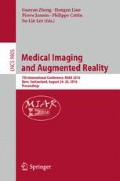Abstract
The need to look into human body for better diagnosis, improved surgical planning and minimally invasive surgery led to breakthroughs in medical imaging. But, intra-operatively a surgeon needs to look at multi-modal imaging data on multiple displays and to fuse the multi-modal data in the context of the patient. This adds extra mental effort for the surgeon in an already high cognitive load surgery. The obvious solution to augment medical object in the context of patient suffers from inaccurate depth perception. In the past, some visualizations have addressed the issue of wrong depth perception, but not without interfering with the natural intuitive view of the surgeon. Therefore, in the current work an interactive depth of focus (DoF) blur method for AR is proposed. It mimics the naturally present DoF blur effect in a microscope. DoF blur forces the cue of accommodation and convergence to come into effect and holds potential to give near metric accuracy; its quality decreases with distance. This makes it suitable for microscopic neurosurgical applications with smaller working depth ranges.
Access this chapter
Tax calculation will be finalised at checkout
Purchases are for personal use only
References
Azuma, R., Baillot, Y., Behringer, R., Feiner, S., Julier, S., MacIntyre, B.: Recent advances in augmented reality. IEEE Comput. Graph. Appl. 21(6), 34–47 (2001)
Bajura, M., Fuchs, H., Ohbuchi, R.: Merging virtual objects with the real world: seeing ultrasound imagery within the patient. ACM SIGGRAPH Comput. Graph. 26(2), 203–210. ACM(1992)
Krüger, J., Schneider, J., Westermann, R.: Clearview: an interactive context preserving hotspot visualization technique. IEEE Trans. Vis. Comput. Graph. 12(5), 941–948 (2006)
Ropinski, Timo, Steinicke, Frank, Hinrichs, Klaus H.: Visually Supporting Depth Perception in Angiography Imaging. In: Butz, Andreas, Fisher, Brian, Krüger, Antonio, Olivier, Patrick (eds.) SG 2006. LNCS, vol. 4073, pp. 93–104. Springer, Heidelberg (2006)
Ware, C.: Information Visualization: Perception for Design. Elsevier, Amsterdam (2012)
Johnson, L.G., Edwards, P., Hawkes, D.: Surface transparency makes stereo overlays unpredictable: the implications for augmented reality. Stud. Health Technol. Inform. 94, 131–136 (2003)
Landy, M.S., Maloney, L.T., Johnston, E.B., Young, M.: Measurement and modeling of depth cue combination: in defense of weak fusion. Vis. Res. 35(3), 389–412 (1995)
Cutting, J., Vishton, P.: Perceiving layout and knowing distances. In: Perception of Space and Motion, pp. 69–117 (1995)
Sundet, J.: Effects of colour on perceived depth: review of experiments and evalutaion of theories. Scand. J. Psychol. 19(1), 133–143 (1978)
Dixon, B.J., Daly, M.J., Chan, H., Vescan, A.D., Witterick, I.J., Irish, J.C.: Surgeons blinded by enhanced navigation: the effect of augmented reality on attention. Surg. Endosc. 27(2), 454–461 (2013)
Bailey, R., Grimm, C., Davoli, C.: The effect of warm and cool object colors on depth ordering. In: Proceedings of the 3rd Symposium on Applied Perception in Graphics and Visualization, p. 161. ACM (2006)
Nissen, M.J., Pokorny, J.: Wavelength effects on simple reaction time. Percept. Psychophysics 22(5), 457–462 (1977)
Breitmeyer, B.G., Breier, J.I.: Effects of background color on reaction time to stimuli varying in size and contrast: inferences about human M channels. Vision. Res. 34(8), 1039–1045 (1994)
Potmesil, M., Chakravarty, I.: A lens and aperture camera model for synthetic image generation. ACM SIGGRAPH Comput. Graph. 15(3), 297–305 (1981)
Kersten-Oertel, Marta, Drouin, Simon, Chen, Sean J.S., Collins, DLouis: Volume Visualization for Neurovascular Augmented Reality Surgery. In: Liao, Hongen, Linte, Cristian A., Masamune, Ken, Peters, Terry M., Zheng, Guoyan (eds.) MIAR 2013 and AE-CAI 2013. LNCS, vol. 8090, pp. 211–220. Springer, Heidelberg (2013)
Shuhaiber, J.H.: Augmented reality in surgery. Arch. Surg. 139(2), 170–174 (2004)
Bichlmeier, C., Wimmer, F., Heining, S.M., Navab, N.: Contextual anatomic mimesis hybrid in-situ visualization method for improving multi-sensory depth perception in medical augmented reality. In: ISMAR, pp. 129–138 (2007)
Cleary, K., Peters, T.M.: Image-guided interventions: technology review and clinical applications. Ann. Rev. Biomed. Eng. 12, 119–142 (2010)
Kersten-Oertel, M., Jannin, P., Collins, D.L.: The state of the art of visualization in mixed reality image guided surgery. Comput. Med. Imaging Graph. 37(2), 98–112 (2013)
Roberts, D.W., Strohbehn, J.W., Hatch, J.F., Murray, W., Kettenberger, H.: A frameless stereotaxic integration of computerized tomographic imaging and the operating microscope. J. Neurosurg. 65(4), 545–549 (1986)
Tedford Jr., W.H., Bergquist, S.L., Flynn, W.E.: The size-color illusion. J. Gen. Psychol. 97(1), 145–149 (1977)
Hillaire, S., Lécuyer, A., Cozot, R., Casiez, G.: Depth-of-field blur effects for first-person navigation in virtual environments. In: Proceedings of the ACM Symposium on Virtual Reality Software and Technology, pp. 203–206 (2007)
Hillaire, S., Lécuyer, A., Cozot, R., Casiez, G.: Using an eye-tracking system to improve camera motions and depth-of-field blur effects in virtual environments. In: IEEE Virtual Reality Conference, pp. 47–50 (2008)
Arnheim, R.: Art and Visual Perception: A Psychology of the Creative Eye. Univ of California Press, Berkeley (1954)
Gilinsky, A.S.: Perceived size and distance in visual space. Psychol. Rev. 58(6), 460 (1951)
Author information
Authors and Affiliations
Corresponding author
Editor information
Editors and Affiliations
Rights and permissions
Copyright information
© 2016 Springer International Publishing Switzerland
About this paper
Cite this paper
Kalia, M., Schulte zu Berge, C., Roodaki, H., Chakraborty, C., Navab, N. (2016). Interactive Depth of Focus for Improved Depth Perception. In: Zheng, G., Liao, H., Jannin, P., Cattin, P., Lee, SL. (eds) Medical Imaging and Augmented Reality. MIAR 2016. Lecture Notes in Computer Science(), vol 9805. Springer, Cham. https://doi.org/10.1007/978-3-319-43775-0_20
Download citation
DOI: https://doi.org/10.1007/978-3-319-43775-0_20
Published:
Publisher Name: Springer, Cham
Print ISBN: 978-3-319-43774-3
Online ISBN: 978-3-319-43775-0
eBook Packages: Computer ScienceComputer Science (R0)

